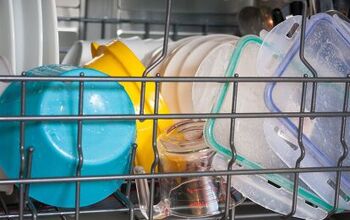Can You Put A Dishwasher Under The Sink? (Find Out Now!)

Installing a dishwasher under a kitchen sink is not common practice, but such doesn’t mean it can’t be done. This configuration is often found in small, compact kitchens, as here space is limited to the point where every inch counts.
This article will explain what kind of dishwasher can go under a sink, and the benefits and drawbacks of putting a dishwasher under the sink will be put forward as well. Finally, some alternative dishwasher locations will be presented, as every homeowner can’t enjoy this sink-dishwasher configuration.
Yes, you can put a dishwasher under a sink, but you’ll need a special dishwasher to ensure this configuration is useful. There are pros and cons associated with putting a dishwasher under a sink, but such a configuration often provides more upside than downside. This configuration is ideal when there isn’t a lot of space in the kitchen.
Do You Need Appliance Installation or Replacement?
Get free, zero-commitment quotes from pro contractors near you.

Can a Dishwasher Fit Under a Sink?
A dishwasher that dips low in the back will be good for a 6-inch deep sink. The only quality that distinguishes a low-dipping dishwasher from a regular dishwasher is that the low-dipping unit has a slanted top rack; the back is lower than the front.
The lower rack is level, just like it would be in a regular dishwasher. Moreover, this kind of unit has nearly as much interior space as a regular dishwasher. And with this kind of configuration, you can still wash dishes by hand easily.
Putting a Dishwasher Under the Sink: Pros and Cons
Before you put a dishwasher under the sink, you need to know the pros and cons associated with doing so. These are listed below. To ensure installation goes off without a hitch, get a professional to install the dishwasher for you.
Pro: Space-Saving
The main reason why the sink-dishwasher configuration is used is that it saves space. Most of the time, a dishwasher is installed next to the sink, under the countertop, and adjacent to cabinets.
But if you’re using a sink that takes up the entire length of a small kitchen wall, then there won’t be any nearby room for the dishwasher. In this instance, having a dishwasher under the sink ensures that this one small stretch of kitchen space provides a lot of utility.
Pro: The Dishwasher Will Still Be Effective
Some assume that when a dishwasher is under the sink, it can’t perform well, but such is far from the case. As was said earlier, there are dishwashers specifically designed for such a configuration, and these can clean effectively and hold plenty of dishes as well.
Moreover, if you like to rinse off dishes before putting them in the dishwasher, this configuration is ideal. You won’t have to walk across the kitchen with dripping dishes, as the dishwasher will be right below you.
Pro: Simpler Configuration
When the dishwasher is directly below the sink, arranging the drain pipe and other necessary components is a lot simpler. And when the dishwasher is directly under the sink, you don’t have to worry about backflow issues and leaks as much.
In the standard configuration, the drain pipe is extended several feet to connect the sink and dishwasher, and sometimes complications can arise because the distance is too far or there’s a height imbalance.
Pro: Hand-Washing Dishes Is Still Possible
Just because there’s a dishwasher under the sink doesn’t mean you can’t hand-wash dishes anymore. In fact, some homeowners prefer hand-washing dishes over using a dishwasher. These homeowners cite elbow grease as what’s really needed to remove leftover food and other particles.
While elbow grease does go a long way in removing particles from dishes, human hands can’t withstand the scalding and cleansing water that a dishwasher utilizes to make dishes spotless.
Con: Hard to Access Interior Components When There’s a Leak
While keeping everything in one spot is seen as convenient by some homeowners, others view this setup as an inconvenience, especially when there’s a leak. If one of the components has sprung a leak, accessing it might be difficult, as you’ll probably have to navigate around sink components.
This wouldn’t be the case if the dishwasher was detached from the sink. In this instance, you would only be dealing with the dishwasher components if a leak sprung.
One thing to keep in mind, however, is that a leak may not spread a great distance when the dishwasher is under the sink. In the standard configuration, on the other hand, there’s the chance that the leak affects cabinets, nearby appliances, and a wide section of kitchen floor.
Con: Too Much Happening At Once
Some homeowners don’t like when there’s a lot happening in such a small space, and it’s fair to say these homeowners wouldn’t like having a dishwasher under the sink. With this configuration, there are a lot of components packed together, but this won’t be an issue if things are arranged well.
In most cases, however, it’s hard to get the setup organized. But as long as the system works fine, and the arrangement can be hidden from view, there’s no harm in having a dishwasher under a sink.
Con: Space Under the Sink Could Be Used for Something Else
Then there are homeowners who prefer to use the space under the sink for storage. It’s here where dish detergents, cleaning products, sponges, brushes, rags, and other kitchen cleaning materials can be held.
If you’re using this space to hold a dishwasher, you’ll need to find another spot for your cleaning products; this shouldn’t be a problem. It may be challenging if your kitchen doesn’t have a lot of space, but in this instance you would just need to keep the kitchen cleaning products in another part of the home.
Do You Need Appliance Installation or Replacement?
Get free, zero-commitment quotes from pro contractors near you.

Other Locations for the Dishwasher
Under the sink isn’t the only convenient spot for a dishwasher when there’s minimal space in the kitchen. The spaces listed below can also accommodate a dishwasher:
- Behind a cupboard door.
- In a corner cabinet.
- In drawers (if you’re using dish drawers).
Related Guide

Matt loves everything DIY. He has been learning and practicing different trades since he was a kid, and he's often the first one called when a friend or family member needs a helping hand at home. Matt loves to work with wood and stone, and landscaping is by far his most favorite pastime.
More by Matthew Mountain

















![How To Reset A Whirlpool Cabrio Washer [In 5 Easy Steps!]](https://cdn-fastly.upgradedhome.com/media/2023/07/31/9076531/how-to-reset-a-whirlpool-cabrio-washer-in-5-easy-steps.jpg?size=350x220)









